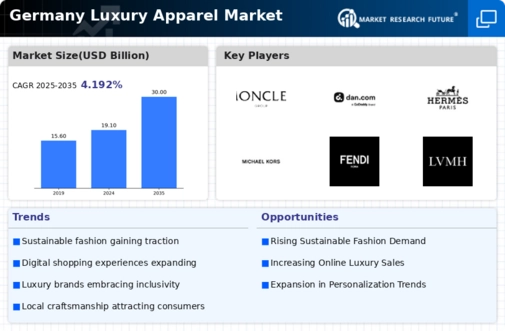E-commerce Expansion
The luxury apparel market in Germany is significantly influenced by the rapid expansion of e-commerce platforms. In 2025, online sales of luxury goods are expected to account for over 25% of total luxury apparel sales in the country. This shift towards digital shopping is reshaping consumer behavior, as more individuals prefer the convenience of purchasing luxury items online. The luxury apparel market is adapting to this trend by enhancing online shopping experiences, offering personalized services, and ensuring secure payment options. Additionally, the rise of social media marketing is facilitating brand visibility and engagement, further driving online sales. As consumers increasingly turn to e-commerce for luxury apparel, brands that effectively leverage digital channels are likely to gain a competitive edge.
Rising Disposable Income
The luxury apparel market in Germany is experiencing growth driven by an increase in disposable income among consumers. As economic conditions improve, individuals are more willing to invest in high-end fashion. In 2025, the average disposable income in Germany is projected to rise by approximately 3.5%, which could lead to a greater demand for luxury apparel. This trend indicates that consumers are prioritizing quality and exclusivity in their clothing choices. The luxury apparel market is likely to benefit from this shift, as affluent consumers seek to enhance their wardrobes with premium brands. Furthermore, the increasing number of high-net-worth individuals in Germany suggests a robust market potential for luxury apparel, as these consumers are more inclined to spend on luxury goods.
Influence of Fashion Trends
The luxury apparel market in Germany is heavily influenced by evolving fashion trends and consumer preferences. In 2025, the market is expected to see a shift towards more casual and athleisure styles, reflecting a broader global trend. This change indicates that consumers are seeking comfort without compromising on luxury. The luxury apparel market must adapt to these trends by offering collections that resonate with contemporary lifestyles. Furthermore, collaborations between luxury brands and popular designers or influencers are likely to drive interest and sales. As fashion trends continue to evolve, brands that remain agile and responsive to consumer demands will likely thrive in the competitive landscape of luxury apparel.
Cultural Appreciation for Luxury
Germany has a long-standing cultural appreciation for craftsmanship and quality, which significantly impacts the luxury apparel market. The luxury apparel market benefits from consumers who value heritage brands known for their meticulous attention to detail and superior materials. In 2025, it is anticipated that consumers will increasingly gravitate towards brands that emphasize artisanal production and sustainable practices. This cultural inclination towards quality over quantity suggests that luxury brands focusing on craftsmanship will likely see enhanced loyalty and sales. Additionally, the growing interest in local and European brands may further bolster the luxury apparel market, as consumers seek to support regional craftsmanship and sustainability.
Growing Influence of Social Media
The luxury apparel market in Germany is increasingly shaped by the growing influence of social media platforms. In 2025, it is estimated that over 70% of consumers will rely on social media for fashion inspiration and brand discovery. This trend indicates that the luxury apparel market must engage effectively with consumers through targeted social media campaigns and influencer partnerships. Brands that successfully leverage platforms like Instagram and TikTok are likely to enhance their visibility and attract younger demographics. Furthermore, the interactive nature of social media allows for real-time feedback and engagement, enabling brands to adapt quickly to consumer preferences. As social media continues to play a pivotal role in shaping consumer behavior, its influence on the luxury apparel market is expected to grow.
























Leave a Comment